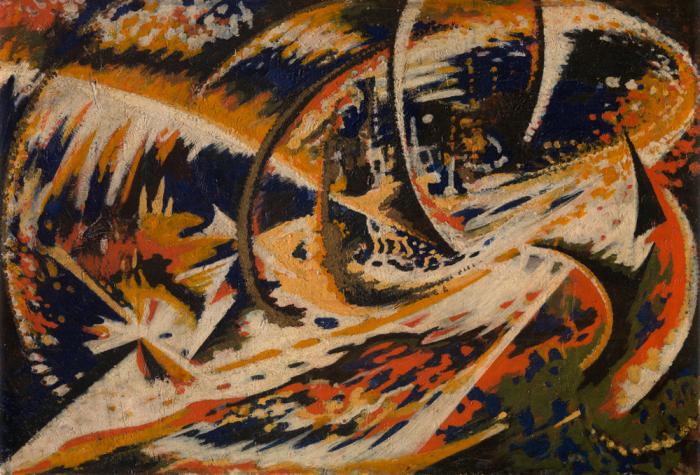The evolution in the arts at the beginning of the 20th Century (Fauvism and Cubism in France, German Expressionism, and Dutch Neo-plasticism) experiences in Belgium a difficult arrival on the scene. Yet, the French Cubists are exhibited by the Cercle des Indépendants already in 1911 in Brussels. The Director and critic William Jelley brings together the work of Alexander Archipenko (1887 - 1964), Robert Delaunay (1885-1941), Albert Gleizes (1881 - 1953), Henri Le Fauconnier (1881 - 1945) and Fernand Léger (1881 - 1955), among others. Major reactions, however, are absent.
Under the influence of this same Jelley, Galerie Giroux brings a traveling exhibition on futuristic painting to Brussels. This is the result of the attention that Futurists receive in February of that year on the occasion of their ‘scandalous exhibition’ Exposition des peintres futurists in the Parisian gallery of Bernheim Jeune. With work by Umberto Boccioni (1882 - 1916), Carlo Carrà (1881 - 1966), Luigi Russolo (1885 - 1947) and Gino Severini (1883 - 1966), the exhibition serves as the starting point of the internationalising of Futurism. On the occasion of the exhibition in Brussels, Filippo Tommaso Marinetti (1876 - 1941) and Boccioni take part in a debate, which ensures for a mention in the newspaper.
It is telling that Jules Schmalzigaug, who grows to be the premier Belgian Futurist, is indeed present in Paris, but not in Brussels. Just as with other Belgian pioneers from the beginning, Georges Vantongerloo and Marthe Donas, shall earn their reputation abroad without having connections with their contemporaries in their own country. In addition to individual paths of life, the First World War shall also play a part in the break in contact and isolated evolution. During the German occupation, the first, hesitant contacts are made, such as with the Summer exhibition of the Brussels circle Doe Stil Voort, among which Felix De Boeck, Victor Servranckx and Jozef Peeters participate along with others. Because of the German occupation, the wave of innovation shall break through only at the end of the War (in 1917-1918).
After the lectures of Theo Van Doesburg (1883 - 1931) in Antwerp (13 February) and Brussels (13 March) in 1920, everything seems to become accelerated. A first, important congregation of international and Belgian avant-gardes is organised by the enterprising promoters of the recently started newspaper annex gallery Sélection, P.G. Van Hecke (1887 - 1967) and André De Ridder (1888 - 1961). In Antwerp, the Royal Art Circle/Art Association presents the Salon der kubisten from 14 July to 12 August. The organisation is by the hands of Sélection. In addition to work by André Lhote (1885 - 1962) and Jean Metzinger (1883-1956) and others, work by Floris Jespers (1889 - 1965) is shown. In the atelier d’Art Contemporain Sélection in Brussels, they organise the exhibition Oeuvres des cubists et néo-cubistes français et belges from 18 September to 8 October. Works by Prosper De Troyer (1880 - 1961), Albert Counhaye (1884 – 1971), Floris Jespers, Paul Joostens and Jozef Peeters are shown in addition to work promoted by the Parisian art dealer Léonce Rosenberg from the Ecole de Paris with Georges Braque (1882 - 1963), Pablo Picasso (1881 - 1973), Juan Gris (1887 - 1927), Fernand Léger (1881 - 1955), André Derain (1880 - 1954), Lhote, Metzinger, Léopold Survage (1879 - 1968) and Severini. Moreover, there are pieces by Le Fauconnier, Raoul Dufy (1877 - 1953), Tsughouharu Foujita (1886-1968), Amedeo Modigliani (1884 - 1920), Valentine Prax (1899 - 1981) and Ossip Zadkine (1890 - 1967).
With the contribution of Marthe Donas, under the pseudonym of Tour-Donas, in the Sélection exposition of the Cubist-orientated group La Section d’Or (4-17 December) the indigenous and expatriated working Belgian artists came together for the first time. This will happen internationally later that year in Geneva with the Exposition Internationale d’Art Moderne, Genève (26.12.1920 - 25.1.1921). The two constructivist centres of Belgium are strongly represented at these outspoken avant-garde exhibitions in the Palais electoral in Geneva. Albert Daenens (1883 - 1952), Felix De Boeck, René Magritte and Karel Maes are sent from the Centre d’Art in Brussels. For Antwerp, the entourage of Jozef Peeters with Jan Cockx (1891 - 1976) as well as Edmond Van Dooren (1896 - 1965) and Prosper De Troyer (1880 - 1961) are present. Donas and Vantongerloo both belong to the Belgian delegation without, however, associating themselves with either of the two groups.
Sergio Servellón
CC-BY-NC (Creative Commons 4.0)
